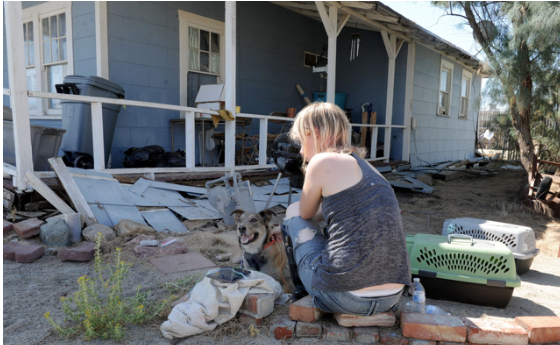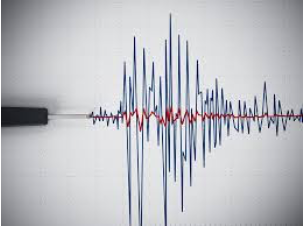CommentsGELFAND’S WORLD--Saying that we told you so isn't polite, but it's something we should all be saying to the politicians in the aftermath of the twin earthquakes and the thousand or so aftershocks that centered out in the desert -- almost as far away as Death Valley it turns out -- and not directly under our feet.
It's fine to tell people to prepare for a major disaster, but what if it had happened here instead of so far away? What if a bigger quake had happened in Los Angeles on the 8th of July with people at work, at school, and on the roads?
Had that been the case, the civic leaders would be telling an unprepared population about how to find Red Cross shelters and how the authorities were attempting to deliver emergency medical care and water for thousands of injured people and hundreds of thousands of the displaced.
Here is how the editor of CityWatch phrased the question: "What if the quake epicenter had been LA ... is the city prepared? Not the fire and police departments, etc. But, what if 2 quakes like Ridgecrest hit LA and power went out and phone service was down ... and it was not a holiday ... wife at a job, kids in school, husband at a job. Transportation out, roads closed. How would families contact each other? How is the city prepared to help?"
We have an inkling of the answers based on what we have been seeing and hearing on the television news the past few days. The videos we have been seeing on television are really ghastly, showing rapid shaking that would knock anybody down, articles thrown off of shelves, and a couple of flash fires erupting. People from other places were left to wonder about the health and safety of their relatives in the affected towns.
What's missing is a comprehensive public understanding of how to react. The immediate instinct in this year 2019 is to reach for the cell phone, but what will that get you? What if cell phone communication fails? If electric power goes out on a wide area, the backup batteries will fail within a few hours and there goes cell phone communication. (Note: Some providers have trucks which can temporarily replace the downed towers, but if we lose hundreds of towers due to simple power outages, what then?) We can confidently predict that in a large enough disaster, the cell phone circuits will be overloaded rapidly, and the system will function, if at all, in a limited way.
We shall repeat here what we have been saying for the past three years: It would be better for the city and county to create a comprehensive program of public awareness and to do so during the period of calm, not when the ground has just stopped shaking.

What's worse is that the city agencies have not brought the public into the planning process in advance. Yes, there are a few trained volunteer groups like CERT and the Auxiliary Communications Service, but the idea of using the tens of thousands of people who would be willing to participate in a minimal amount of organization -- that seems to be lost on them.
And it's not for a lack of asking them. They haven't really taken advantage of the opportunity.
Back to the earthquake experience -- To borrow the old cliche, the experience of finding that the floor underneath you is no longer what a floor is supposed to be, but is throwing you up, down, and sideways -- that is something that concentrates the mind wonderfully. What would it be like in a sizeable metropolis such as our own?
More to the point, suppose the whole Los Angeles area were being tossed around like the small Ridgecrest area has been? In other words, suppose we had the Big One, which would toss us all around for a minute and a half? We could expect damage, injuries, and dislocations equivalent to those desert communities, but over our entire city.
To come back to our editor's questions -- In the news footage, we've seen how streets and roads became impassable. Road crews were still filling and patching over the weekend, and that was based on their ability to get help from several surrounding counties.
On the evening of the first big shock, we saw footage of a darkened community without streetlights or electricity. Television was not providing precise figures about how large an area was knocked out, but imagine this happening over a substantial part of the L.A. basin. We would need something like a thousand times the number of road and electrical repair crews, and we wouldn't have them.
Finally, our editor raises a pertinent question regarding people being off to work and at school. If the roads are interrupted due to downed power lines and fissures, and if communications are either overloaded (what we can expect for cell phones) or non-functional, people will be in fear for the health of their loved ones. As experienced disaster responders have explained, it could be days before families can reunite. People might end up at shelters all across the region, depending on where they happen to be. People commuting from the valley to downtown won't be able to get home for quite a while. Their relatives in the valley will hear stories about broken glass covering the streetscapes and will worry.
In the past, the responders have counseled us to agree on a telephone number in some other state so that families who are displaced can leave messages for each other. You could call Auntie Em, and your folks would learn that their Dorothy is alive and well. This system makes sense in that everyone involved from Auntie Em to your parents know who they are talking about. But this system is flawed, because not everyone has relatives in Kansas or New Jersey. It's time for the phone company and cell phone providers to start thinking about creating special telephone exchanges that can serve the same function on a wide scale.
 It is to mayor Garcetti's credit that he agreed to studies and planning on earthquake preparedness and resilience several years ago. The city has even started the process of upgrading the so-called soft story structures (apartments that sit above garages without a lot of physical support). These are commendable. But what has the City Council done to fund the required upgrades in the Emergency Management component of city government, or in funding substantial numbers of new CERT instructors?
It is to mayor Garcetti's credit that he agreed to studies and planning on earthquake preparedness and resilience several years ago. The city has even started the process of upgrading the so-called soft story structures (apartments that sit above garages without a lot of physical support). These are commendable. But what has the City Council done to fund the required upgrades in the Emergency Management component of city government, or in funding substantial numbers of new CERT instructors?
This site and numerous other groups have been asking for these improvements for the past couple of years. Just ask the Neighborhood Council Emergency Preparedness Alliance about its studies and the recommendations it has made.
Now, all of a sudden, the politicians are lining up to provide advice to the public over a holiday weekend. But where were they during budget negotiations for this fiscal year?
The ultimate hypocrisy came when a group of civic leaders got together in front of the television cameras on Sunday to talk about emergency preparedness in the event of an earthquake. We were shown pictures of emergency kits and suggestions about stocking up on water and saw (but didn't hear) one of the pols talking away in the background. We shouldn't begrudge the politicians their moment in the spotlight, but let's ask the more pertinent question: What does the city of Los Angeles have in its latest fiscal year budget for increased funding to impart personal awareness of how to prepare? What about funding for a serious (not paper-thin) program of neighborhood council programs to do outreach to their populations? Hint: The city has tasked the neighborhood councils to have disaster preparedness plans (they call it Resilience) but have not been serious about coordinating the program, much less funding it adequately.
It's nice that the city fathers were able to get together for photo-ops on a holiday weekend, but every dollar that isn't in the new city budget is hypocrisy writ large.
Being in the middle of an earthquake is a profoundly unnerving experience because none of the usual methods of coping are available at that moment. One earthquake survivor in the Ridgecrest-Trona area talked about trying to exit his building, only to fall down as he reached the door. The survivors of a mobile home fire were forced to deal with the increasing levels of smoke and flames without being sure that they would be on their feet in the next second.
There is one other aspect of the onset of an earthquake that is seldom mentioned by the news media from other parts of the country. When the shaking starts, it takes a couple of seconds to recognize what is happening -- people interviewed by the television reporters tend to explain that they heard something or felt something and only after a moment figured out that they were experiencing an earthquake. But that is the most fearful moment for us, because we recognize the existence of the quake and simultaneously wonder whether we are feeling the first few seconds of a really severe quake that will build and continue. Or will the shaking subside momentarily? It is an extended moment of fearful uncertainty. It could, after all, be the first couple of seconds of a big one.
So let's mention once again a few basic principles of earthquake preparedness. The radio shows and television news are not wrong on this -- you should have enough water for you and your family to survive for 7 to 14 days. The same goes for food, prescription medicines, and pet supplies. That being accomplished, you should take a look around your homes and offices to make sure that sharp or heavy objects won't fall on you.
(Bob Gelfand writes on science, culture, and politics for CityWatch. He can be reached at [email protected])
















